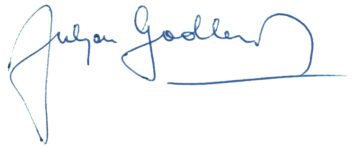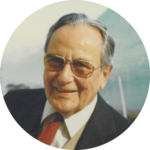Everywhere in the world where there is a matter concerning Polish culture, there lies my heart and my actions.


Dr. Julian Godlewski of the Gozdawa coat of arms (1904 Lviv – 1983 Warsaw)
In 2023, we celebrated in the Museum as Julian Godlewski Year. We reflected on the 120th anniversary of his birth and the 40th of his passing. He was the greatest benefactor of the Polish Museum in Rapperswil, whose gifts shaped its collection and financial support ensured its future for several decades. This exhibition aims to honor Julian Godlewski’s contributions to Polish culture and heritage abroad. It is born not merely out of obligation, but from a profound sense of gratitude towards a most noble individual and patron of the arts. Its necessity stems from the fickle nature of human memory, where noble and altruistic acts often fade into oblivion.
With the announcement of Godlewski Year this spring on Facebook and the Museum’s website, and the subsequent exhibition announcement, many came forward eager to contribute. It turns out that the memory of Julian not only lives on in his family but also in many others who knew him and possess personal mementos. The readiness to share memories, documents, and photographs from private and family collections was overwhelming.
Many expressed genuine appreciation and joy that we are remembering a benefactor and philanthropist, now even forgotten in art history circles, in a format that is no longer common. The closest family of Godlewski, the Gromnickis from Warsaw, reached out to us. They provided us with family stories and photographs from Jul’s youth, as he was affectionately called in the family. Andrzej Skorupski, a colleague of Julian Godlewski, also offered his support, sharing his memories and photographs with us.
Dr. Piotr Chabiera took over the academic supervision of the exhibition. He edited the majority of the collected biographical texts and expertly described the most important art donations made by Julian Godlewski to institutions in Poland.
Julian Godlewski was such a diverse and extraordinary personality that it is impossible to cover all his achievements in one exhibition. Bearing this in mind, a brochure will be prepared, presenting a more detailed biography of Godlewski, including information and photographs that could not be accommodated in the exhibition due to space constraints. A film about Godlewski’s life and work is also in the pipeline, a project to be realized in collaboration with the Museum of Polish History.
The foundation of this exhibition was archival materials from Julian Godlewski’s estate, preserved in the Archive of the Polish Museum under signature I-27. The documentation contained therein, including a curriculum vitae, personal documents of the donor, and a typewritten thesis titled “Julian Godlewski: Patron of Polish Culture” by Zofia Mikulska, enabled the drafting of a biography. Contact with Godlewski’s family and colleagues facilitated the verification and enrichment of this information. Additional materials related to Julian Godlewski are also found in other collections of the Rapperswil archive. Documents from the Society of Friends of the Polish Museum in Rapperswil contain correspondence regarding the first donations to the museum. In the estate of Kazimierz and Halszka Vincenz, there is documentation concerning the principles of establishing the Anna Godlewska Art and Literature Prize by Julian Godlewski. Necessary research was also conducted in the archives of Polish cultural institutions that Julian Godlewski supported. Dr. Piotr Chabiera, the academic guardian of the exhibition, undertook these visits.
An exhibition, however, lives through images, not just text. Suitable iconography was gathered to complement the collected materials. Julian Godlewski’s estate included several photographs, but thanks to the Gromnicki family, we were able to acquire the most interesting photos relating to Jul’s childhood and youth for the exhibition. Andrzej Skorupski provided us with photos of Julian Godlewski’s visits to Poland.
We received permission from Polish cultural institutions to make available photographs of art objects – gifts from Julian Godlewski: from the Royal Castle on Wawel – National Art Collections and the Royal Castle Museum in Warsaw. We thank Mr. Andrzej Konopka for sending a picture of the painting “Manor House in Mereczowszczyzna” from the Kościuszko Museum in Solothurn. To illustrate and supplement biographical information about Julian Godlewski’s work for the Thyssen Corporation, we used photographs compiled by Michaela Barz-Berg on her internet blog. We are deeply grateful for this assistance. My thanks go to the staff at the Fritz Thyssen Foundation Archive in Cologne for providing materials.
I extend my heartfelt thanks to all the aforementioned individuals for their invaluable help and hard work. I am particularly grateful to the Gromnicki family for their immense support in preparing the exhibition. Their details from family histories and photographs from Jul’s youth were invaluable. I also benefited from the help and knowledge of Andrzej Skorupski, Julian Godlewski’s secretary in Warsaw, who shared information and photographs with us. My thanks go to Dr. Piotr Chabiera for taking on the academic supervision of the exhibition, preparing biographical texts, and expertly describing the most important artworks donated by Julian Godlewski to Polish cultural institutions. Every exhibition is always the result of many people’s efforts.
The graphic design was conceived and executed by Monika Czepielewska-Wóycicka. The museum staff also played a part in the exhibition: Sylwia Bielak, Danuta Miż-Miszyn, Anna Tomczak, Ewa Wąsik, Adam Wodyk. I extend my thanks to them as well. I am especially grateful to Director Anna Buchmann for the idea of preparing the exhibition, her support, and help in establishing contacts with other institutions and individuals.
The exhibition has been prepared for online presentation. However, it is also adapted for potential printing on exhibition panels.
Daniel Guzman,
Curator of the Exhibition
This exhibition has been prepared in Polish. Versions in English and German are also planned.
